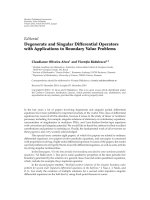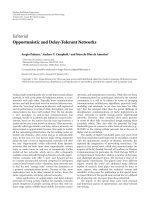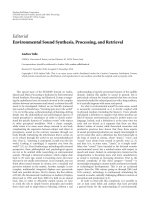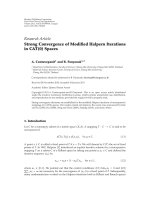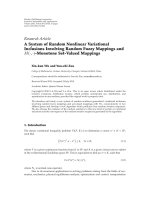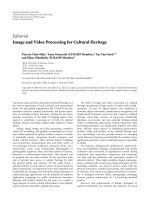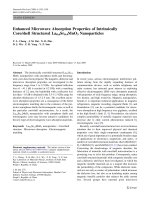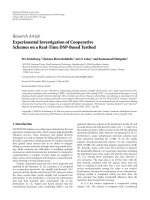Báo cáo hóa học: " Editorial Search and Retrieval of 3D Content and Associated Knowledge Extraction and Propagation" docx
Bạn đang xem bản rút gọn của tài liệu. Xem và tải ngay bản đầy đủ của tài liệu tại đây (888.5 KB, 3 trang )
Hindawi Publishing Corporation
EURASIP Journal on Advances in Signal Processing
Volume 2007, Article ID 39792, 3 pages
doi:10.1155/2007/39792
Editorial
Search and Retrieval of 3D Content and Associated
Knowledge Extraction and Propagation
Petros Daras,
1
Ming Ouhyoung,
2
and Tsuhan Chen
3
1
Informatics and Telematics Institute, Centre for Research and Technology Hellas, 57001 Thermi, Thessaloniki, Greece
2
Communication and Multimedia Lab, Graduate Institute of Networking and Multimedia, Depart ment of Computer Science and
Information Engineering, National Taiwan University, Taipei 106, Taiwan
3
Advanced Multimedia Processing (AMP) Laborator y, Department of Electrical Computer Engineering, Carnegie Mellon University,
Pittsburgh, PA 15213, USA
Received 30 May 2007; Accepted 30 May 2007
Copyright © 2007 Petros Daras et al. This is an open access article distributed under the Creative Commons Attribution License,
which permits unrestricted use, distribution, and reproduction in any medium, provided the original work is properly cited.
With the general availability of 3D digitizers, scanners, and
the technology innovation in 3D graphics and computa-
tional equipment, large collections of 3D graphical mod-
els can be readily built up for different applications (e.g.,
in CAD/CAM, ga mes design, computer animations, manu-
facturing, and molecular biology). For such large databases,
the method whereby 3D models are sought merits careful
consideration. The simple and efficient query -by-content ap-
proach has, up to now, been almost universally adopted in
the literature.
The existing 3D retrieval systems allow the user to per-
form queries by example. The queried 3D model is then pro-
cessed, low-level geometrical features are extrac ted, and sim-
ilar objects are retrieved from a local database. A shortcom-
ing of the methods that have been proposed so far regarding
the 3D object retrieval is that neither is the semantic infor-
mation (high-level features) attached to the (low-level) geo-
metric features of the 3D content, nor are the personaliza-
tion options taken into account, which would significantly
improve the retr ieved results. Moreover, few systems exist so
far to take into account annotation and relevance feedback
techniques, which are very popular among the correspond-
ing content-based image retrieval (CBIR) systems.
Recently, many research groups in companies and univer-
sities have proposed several solutions towards improving the
state of the art in search and retrieval of 3D content. There
are many initiatives to investigate issues such as rotation in-
variant feature extraction methods for 3D content, partial
matching of 3D objects, annotation and relevance feedback
techniques for 3D objects and motion segmentation of 3D
video. The pur pose of the special issue was to bring together
the researchers working on diverse aspects of this important
emerging area in order to identify current status, fundamen-
tal issues, future problems and applications.
We have selected six papers which represent various as-
pects of search and retrieval of 3D content. The paper “Rep-
resentation of 3D and 4D objects based on an associated
curved space and a general coordinate transformations in-
variant description” by E. Paquet presents a new theoreti-
cal approach for the description of multidimensional objects.
The proposed approach is based on a curved space which is
associated to each object. This curved space is characterised
by Riemannian tensors from which invariant quantities are
defined. A descriptor or index is constructed from those in-
variants for which a statistical and an abstract graphs rep-
resentation are associated. The obtained representations are
invariant under general coordinate transformations.
The work entitled “3D model search and retrieval using
the spherical trace transform” by D. Zarpalas et al. presents
a novel methodology for content-based search and retrie v al
of 3D objects. The method is as follows: after proper posi-
tioning of the 3D objects using translation and scaling, a set
of functionals is applied to the 3D model producing a new
domain of concentric spheres. In this new domain, a new
set of functionals is applied, resulting in a descriptor vector
which is completely rotation invariant and thus suitable for
3D model matching. Further, a novel method of assigning
weights is proposed, which takes into account the discrim-
inative power of each descriptor. By doing so, the retrieved
results are significantly improved.
The paper “Density-based 3D shape descriptors” by C.
Burak Akg
¨
ul et al. presents a novel probabilistic framework
for the extraction of density-based 3D shape descriptors
using kernel density estimation. The descriptors are derived
2 EURASIP Journal on Advances in Signal Processing
from the probability density functions (pdf) of local surface
features characterizing the 3D object geometry. Assuming
that the 3D object shape is represented as a mesh consisting
of triangles with arbitrary size and shape, the method pro-
vides efficient means to approximate the moments of geo-
metric features on a triangle basis. The proposed framework
produces a number of 3D shape descriptors that prove to be
quite discriminative in retrieval applications.
The paper “Content-based object movie retrieval and rel-
evance feedbacks” by C C. Chiang et al. deals with object
movies. An object movie refers to a set of images captured
from different perspectives around a 3D object. Object movie
provides a good representation of a physical object because it
can provide 3D interactive viewing effect, but does not re-
quire 3D model reconstruction. In this work, in order to re-
trieve the desired object movie from the database, the au-
thors first map an object movie into the sampling of a man-
ifold in the feature space. Two different layers of feature de-
scriptors, dense and condensed, are designed to sample the
manifold for representing object movies. Based on these de-
scriptors, they define the dissimilarity measure between the
query and the target in the object movie database. The query
they considered can be either an entire object movie or sim-
ply a subset of views. They further design a relevance feed-
back approach to improve the retrieved results.
The work entitled “Motion segmentation and retrieval
for 3D video based on modified shape distribution” by T.
Yamasaki and K. Aizawa presents a similar motion search
and retrieval system for 3D video based on a modified shape
distribution algorithm. In the presented work, three funda-
mental functions for efficient retrieval were developed: fea-
ture extraction, motion segmentation, and similarity evalu-
ation. Stable-shape feature representation of 3D models was
realized by a modified shape distribution algorithm. Motion
segmentation was conducted by analyzing the degree of mo-
tion using the extracted feature vectors. Then, similar motion
retrieval achieved by employing the dynamic programming
algorithm in the feature vector space.
Finally, in the paper “Adaptive processing of range
scanned head: synthesis of personalized animated human
face representation with multiple-level radial basis function”
by C. Chen and E. C. Prakash, an animation s ystem for per-
sonalized human head, is presented. Landmarks compliant
to MPEG-4 facial definition parameters (FDP) are initially
labeled on both template model and any target human head
model as priori knowledge. The deformation from the tem-
plate model to the target head is through a multilevel training
process. Both general radial basis function (RBF) and com-
pactly supported radial basis function (CSRBF) are applied
to ensure the fidelity of the global shape and face features.
Animation factor is also adapted so that the deformed model
still can be considered as an animated head. Situations with
defective scanned data are also discussed in this paper.
This special issue has only covered a small portion of the
various research directions in the arena of Search and Re-
trieval of 3D Content and Associated Knowledge Extraction
and Propagation. However , we hope that it provides with
ample motivation for the readers to investigate challenging
problems in this new and exciting field. We hope that you
will enjoy this special issue.
Petros Daras
Ming Ouhyoung
Tsuhan Chen
Petros Daras was born in Athens, Greece,
in 1974, and he is a Senior Researcher at
the Informatics and Telematics Institute. He
received the Diploma degree in electrical
and computer engineering, the M.S. degree
in medical informatics, and the Ph.D. de-
gree in electrical and computer engineer-
ing from the Aristotle University of Thes-
saloniki, Greece, in 1999, 2002, and 2005,
respectively. His main research interests in-
clude computer vision, search and retrieval of 3D objects, the
MPEG-4 standard, peer-to-peer technologies, and medical infor-
matics. He has been involved in more than 15 European and na-
tional research projects. Dr. Daras is a Member of the Technical
Chamber of Greece.
Ming Ouhyoung received the B.S. and M.S.
degrees in electrical engineering from the
National Taiwan University, Taipei, in 1981
and 1985, respectively. He received the
Ph.D. degree in computer science from the
University of North Carolina at Chapel Hill
in January, 1990. He was a Member of the
technical staff at AT&T Bell Laboratories,
Middle-town, during 1990–1991. Since Au-
gust 1991, he has been an Associate Profes-
sor in the Department of Computer Science and Information En-
gineering, National Taiwan University. Then since August 1995, he
became a Professor. He was the Director of the Center of Excellence
for Research in Computer Systems, College of Engineering, from
August 1998 to July 2000, and was the Chairman of the Depart-
ment of CSIE from August 2000 to July 2002. He is currently the
deputy Dean of College of EECS. He has published over 100 tech-
nical papers on computer graphics, virtual reality, and multimedia
systems. He is a Member of ACM and IEEE.
Tsuhan Chen has been with the Depart-
ment of Electrical and Computer Engineer-
ing, Carnegie Mellon University, since Oc-
tober 1997, where he is a Professor and an
Associate Head. From August 1993 to Oc-
tober 1997, he worked at AT&T Bell Lab-
oratories. He received the M.S. and Ph.D.
degrees in electrical engineering from the
California Institute of Technology in 1990
and 1993, respectively. He received the B.S.
degree in electrical engineering from the National Taiwan Uni-
versity in 1987. He served as the Editor-in-Chief for IEEE Trans-
actions on Multimedia in 2002–2004. He also served in the Ed-
itorial Board of IEEE Signal Processing Magazine and as an As-
sociate Editor for IEEE Transactions on Circuits and Systems for
Video Technology, Transactions on Image Processing, Trans. on
Signal Processing, and Transactions on Multimedia. He coedited
a book titled Multimedia Systems, Standards, and Networks.He
received the Charles Wilts Prize at California Institute of Tech-
nology. He was a recipient of the National Science Foundation
Petros Daras et al. 3
CAREER Award. He received the Benjamin Richard Teare Teaching
Award at the Carneg ie Mellon University. He is elected to Board
of Governors, IEEE Signal Processing Society. He is a Member of
Phi Tau Phi Scholastic Honor Society, Fellow of IEEE, and Distin-
guished Lecturer of Signal Processing Society.
